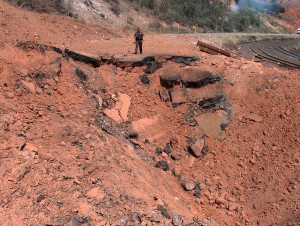Sneak kaboom

Scientists are using the Mira supercomputer to explore what causes evenly burning fires to detonate into unexpectedly powerful explosions like one 10 years ago that destroyed a section of Utah highway and adjacent railway. (Photo: Utah Department of Transportation.)
In August 2005, in a remote part of Spanish Fork Canyon, Utah, a tractor-trailer overturned. A fire started in the engine compartment and spread to the load – 8,400 cylindrical devices containing the mining explosive pentolite. The blast injured some people nearby but killed no one. To the surprise even of explosives experts, the explosion left a crater 24 meters wide and 10 meters deep.
The eruption was orders of magnitude more powerful than anyone would have expected. The current understanding of explosions holds that the event should have been a case of deflagration, which would have limited damage.
In deflagration, burning material heats and ignites adjacent material; fire progresses through a flammable or explosive substance at an even pace. In slow-burning materials such as wood and wax, deflagration gives the steady flame of a campfire or a candle. With faster-burning materials, such as pentolite, the material burns so fast that it creates an explosion – a mass of rapidly expanding gases.
But the Utah accident didn’t stop with deflagration. The size of the crater showed it progressed to a far more violent type of explosion: detonation, in which a pressure wave forms inside the fire and expands throughout the material faster than the speed of sound. The high pressure of this shock wave can ignite nearly all of the explosive material in milliseconds, before the thermal explosion can throw that material outward and away from the ignition site. This more violent type of explosion is harder to establish when flammable gases are the primary fuel, yet detonation is suspected in several disastrous industrial accidents and coal mine explosions.
This phenomenon, deflagration-to-detonation transition (DDT), transforms limited explosions into catastrophic ones, with detonation releasing about 100,000 times more energy than deflagration. Yet much of the process remains a mystery.
Using supercomputers at national laboratories, two research groups are making major contributions to the understanding of DDT.
Martin Berzins of the University of Utah in Salt Lake City and his colleagues simulated the Spanish Fork Canyon explosion using the Oak Ridge Leadership Computing Facility’s Titan, a Cray XK7, and Mira, an IBM Blue Gene/Q at the Argonne Leadership Computing Facility.
“It took five and a half years to actually model the detonation, to make it possible to model at a scale needed to see what was actually happening,” Berzins says. A major hurdle: ensuring the Uintah code could simulate the event’s full scale in three dimensions, a task requiring between 64,000 and 500,000 CPU cores.
Graduate student Jacqueline Beckvermit carried out the simulation. She and Berzins collaborated with University of Utah colleagues Andrew Bezdjian, Todd Harman, Justin Luitjens, Qingyu Meng and Joseph R. Peterson; Scott Bardenhagen of Mesomechanics LLC, Santa Fe, New Mexico; and Charles A. Wight of Weber State University in Ogden, Utah. The group used the Uintah Computational Framework, a simulation code originated and developed at C-SAFE, the Department of Energy’s Center for the Simulation of Accidental Fires and Explosions at the University of Utah.




